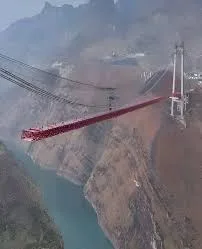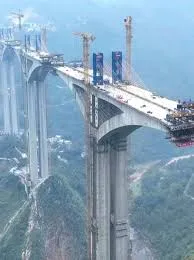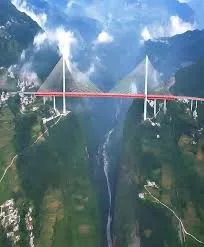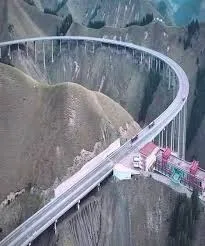The Guozigou Bridge: A Triumph of Engineering in Xinjiang’s Rugged Terrain
Nestled in the dramatic landscape of China’s Xinjiang Uyghur Autonomous Region, the Guozigou Bridge stands as a marvel of modern civil engineering. As a vital component of the G30 Lianyungang-Khorgas Expressway, this cable-stayed bridge (often mistakenly referred to as an arch bridge) spans the formidable Guozigou Valley in Huocheng County, connecting isolated mountainous communities with accessible terrain. Completed in 2011, the bridge is celebrated for its innovative design, ability to withstand extreme conditions, and transformative impact on regional connectivity.

Conquering the Guozigou Valley
The Guozigou Bridge, also known as Talki Bridge, is a critical link in the G30 Expressway, a major east-west artery stretching from Lianyungang to Khorgas near the Kazakhstan border. Spanning 360 meters (1,180 feet) across the valley, the bridge soars 180 meters (590 feet) above the valley floor, with two towering H-frame ladder towers reaching 215.5 meters (707 feet) and 209.5 meters (687 feet). Its main span configuration of 170+360+170 meters and an N-shaped truss deck, 6 meters deep and 26.93 meters wide, make it one of the highest and most remote cable-stayed bridges in the world. The nearby Xiazigou Bridge, with 120-meter-tall piers, complements it, forming part of a spiral descent that navigates the region’s steep 1,200-meter elevation drop over 40 kilometers from Sayram Lake to Lucaogouzhen.

The bridge’s “S” shape, necessitated by the winding mountain roads, enhances its visual grandeur while ensuring navigable gradients for traffic. Set against a backdrop of snow-capped peaks, lush forests, and wildflower-strewn valleys, the Guozigou Bridge blends functionality with aesthetic splendor, earning it a reputation as a scenic and engineering masterpiece.
Engineering Challenges and Innovations
Constructing the Guozigou Bridge was a feat of human perseverance, given Xinjiang’s rugged terrain and harsh climate. The region’s complex geological conditions, including seismic activity, demanded a robust design. Engineers used high-strength steel and reinforced concrete to ensure durability, crafting a structure capable of withstanding temperatures as low as -40°C, winds up to 100 km/h, and frequent earthquakes. The cable-stayed design, with its tall towers and stable truss deck, was chosen for its strength and ability to handle the valley’s steep, irregular topography.

Innovative construction techniques were critical to overcoming these challenges. The bridge’s towers, built like ladders to optimize stability, support the deck at a dizzying height, requiring precise engineering to maintain structural integrity. The project also integrated “four new” advancements—new technology, structure, techniques, and equipment—marking a milestone in Xinjiang’s highway construction history. The nearby spiral loop and tunnel, part of the G30’s descent, further showcase the project’s ambitious scope, winding the expressway around and under itself in a rare feat of highway engineering.

Transforming Connectivity and Economy
Before the Guozigou Bridge, the Guozigou Valley posed a near-impassable barrier, isolating communities in the Ili Kazakh Autonomous Prefecture and hindering trade and travel. The bridge, opened in 2011, slashed travel times, enabling year-round access between Ili Prefecture and Urumqi, Xinjiang’s capital. This improved connectivity has boosted economic development, facilitating the transport of goods and people and strengthening ties between China and Central Asia via the G30 Expressway, a key link in the Belt and Road Initiative.
The bridge’s impact extends beyond function. Its scenic observation points attract tourists and photographers, drawn to its “S” shape winding through the valley’s stunning landscape. Open year-round without entry fees, it has become a symbol of progress, showcasing China’s ability to conquer geographical barriers through infrastructure.
A Symbol of Ingenuity
The Guozigou Bridge is more than a transportation link—it’s a testament to human ingenuity and resilience. Its ability to withstand extreme weather and seismic activity, combined with its innovative design, has earned it accolades for engineering excellence. As a vital artery in Xinjiang’s rugged northwest, it continues to transform the region, connecting communities and fostering economic growth while harmonizing with the dramatic beauty of the Guozigou Valley. For travelers and engineers alike, the bridge stands as a towering achievement, bridging the past with a future of possibility.





